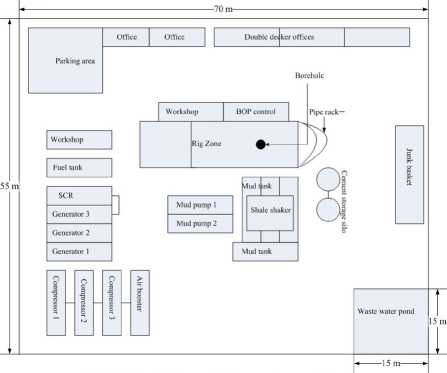5441336915
Report 8
77
Cherutich
4.9.1 The size of the well pad
Before drilling commences, access roads, water lines and the well pad are prepared. The well pad size depends on the specific layout of the rig in use. Most of the geothermal reservoirs are located in national or gamę reserve parks, thus the need for the drilling operation to minimise environmental degradation, especially with regard to the well pad design size. Since the top drive rig is compact in area, the size of the well site is smali, thus the environmental impact is reduced. This gives the top drive an advantage over the other, especially when drilling in a restricted area such as inside national parks or in a residential area where space is limited.
Figurę 10 shows the layout of a platform for one of the rotary rigs used in Olkaria, Kenya, and it covers an approximate area of 8,000 m2 with dimensions of 100*80 m. The Icelandic well pad, as shown in Figurę 11, has an approximately area of 3,850 m2 with dimensions of 70*55 m. Comparing the two well pads, it can be seen that the Kenyan well pad has twice the area compared to that of the Icelandic well pad. One factor that contributes to this is that the Icelandic site office containers are placed on top of one another, thus reducing the total space they occupy.

FIGURĘ 11: Icelandic well platform using a top drive rig
4.9.2 Noise level
Sometimes the rig is reąuired to drill in a residential area where the noise level from the rig operation needs to be kept as minimal as possible. The main source of noise in the rig operation are the big generators which supply power for rig operation, therefore the exhaust of the engine should be inside sound insulated containers and fitted with silencers to minimise the noise level. Most of the modem rigs have their components fitted with a noise insulation system meeting the European standard noise level of no morę than 85 dB at 1 m distance within an 8 hour exposure.
Wyszukiwarka
Podobne podstrony:
Report 8 69 Cherutich TABLE 1: Comparison of thermal output of wells drilled with and without aerate
libmemcached Get Functlons The libmemcached functions provide both direct access to a single item, a
Report 8 79 Cherutich Size of the casing: The casing design is verv important because this indicates
Report 8 81 Cherutich 5.8 Cementing The main purpose of cementing is to hołd the casing in place, to
Report 8 67 Cherutich Site preparation: A drill rig is heavy and because of the high loads invoIved,
Report 8 71 Cherutich 4.2 Drill string design The drill string is a very important component of the
ESOPT State-of-the-art reportPenetration testing in CanadaW.J. Eden Because of the size of the count
koliber z motylem i (2) 4 4 This chart does not represent the finished size of this design,How To
smpb 48 WORDS OF PRAISEBY WELL-KNOWN MEN The Bimmtr College of Satureopathy, Dece Mr. Atlas
NPL Report MATC(A) 164 Finał polishing of the samples was carried out by hand using a gamma aluminid
Effect Of Dividends On Slock Prices 8 equity ratio has negative relation with stock return while siz
cw0020 Q
Dessin Leonardo? Vinci Distance from the Sun to the?rth and the size of the Moon . i^kn . i uv ’
Distance from the Sun to the?rth and the size of the Moon «(**( *rw ..ał -—i —— *.
(I www.mtuexam.blogspot.in Cl KCV + (ii) A materiał is crushed in Jaw crusher and the average size o
więcej podobnych podstron